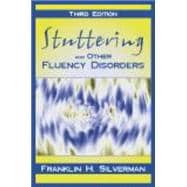| Preface | p. vii |
| Introduction: The "Why" of this Book | p. 1 |
| Normal and Abnormal Speech Disfluency | p. 5 |
| Instructional Objectives | p. 5 |
| What Are Moments of Speech Disfluency? | p. 7 |
| Four Disorders that Yield Moments of Abnormal Speech Disfluency | p. 9 |
| Other Disorders Reported to Have a Stuttering-like Symptom | p. 16 |
| When Are Moments of Speech Disfluency Symptoms of a Fluency Disorder? | p. 20 |
| Fluency Disorders as Impairments, Disabilities, and Handicaps | p. 29 |
| Assignments | p. 31 |
| Symptomatology and Phenomenology of Fluency Disorders | p. 33 |
| Instructional Objectives | p. 33 |
| Symptomatology and Phenomenology of Stuttering | p. 34 |
| Symptomatology and Phenomenology of Cluttering | p. 59 |
| Symptomatology and Phenomenology of Neurogenic Acquired Stuttering | p. 61 |
| Symptomatology and Phenomenology of Psychogenic Acquired Stuttering | p. 63 |
| Assignments | p. 64 |
| The Person Who Has a Fluency Disorder | p. 67 |
| Instructional Objectives | p. 67 |
| The Person Who Stutters | p. 69 |
| The Person Who Manifests Cluttering | p. 89 |
| The Person Who Manifests Neurogenic Acquired Stuttering | p. 91 |
| The Person Who Manifests Psychogenic Acquired Stuttering | p. 92 |
| Assignments | p. 93 |
| Onset and Development | p. 95 |
| Instructional Objectives | p. 95 |
| Onset of Stuttering | p. 96 |
| Development of Stuttering | p. 104 |
| Onset and Development of Cluttering | p. 112 |
| Onset and Development of Neurogenic Acquired Stuttering | p. 113 |
| Onset and Development of Psychogenic Acquired Stuttering | p. 114 |
| Assignments | p. 115 |
| Etiology | p. 117 |
| Instructional Objectives | p. 117 |
| How Have Fluency Disorders Been Explained Historically? | p. 118 |
| Schemes for Categorizing Hypotheses about Stuttering | p. 129 |
| Is the Cause of Stuttering Physiological or Psychological? | p. 131 |
| What Factors Cause One Child to Be More at Risk for Stuttering than Another? | p. 132 |
| Why Do People Begin to Stutter? | p. 138 |
| Why Do People Continue to Stutter? | p. 157 |
| To What Extent Is Stuttering Learned Behavior? | p. 159 |
| Is Stuttering Truly a Disorder of Speech? | p. 161 |
| Is the Mystery of Stuttering Solvable? | p. 164 |
| Etiology of Cluttering | p. 165 |
| Etiology of Neurogenic Acquired Stuttering | p. 166 |
| Etiology of Psychogenic Acquired Stuttering | p. 166 |
| Assignments | p. 166 |
| Evaluation: Principles and Methods | p. 169 |
| Instructional Objectives | p. 169 |
| Reasons for Evaluating Speech Fluency | p. 170 |
| An Overview of the Evaluation Process | p. 173 |
| Cultural Considerations | p. 175 |
| Determining Whether a Client Has a Fluency Disorder | p. 176 |
| Determining Whether the Client Is at Risk for Stuttering or Developing a Stuttering Overlay on Another Fluency Disorder | p. 179 |
| Determining the Type of Fluency Disorder | p. 179 |
| Identifying the Behaviors in the Set that Defines a Client's Fluency Disorder | p. 181 |
| Answering Questions | p. 186 |
| Assessing Motivation | p. 203 |
| Making a Prognosis | p. 206 |
| Reasons for Not Scheduling Therapy for a Client Who Has a Disorder | p. 209 |
| Communicating Questions, Answers, and Recommendations | p. 211 |
| Assignments | p. 212 |
| Intervention: Principles, Goals, and Strategies | p. 213 |
| Instructional Objectives | p. 213 |
| "Do No Harm" | p. 216 |
| The Therapeutic Relationship | p. 222 |
| Cultural Considerations | p. 224 |
| Establishing Goals | p. 225 |
| Selecting and Implementing Intervention Strategies | p. 231 |
| Selecting and Implementing Intervention Strategies for Cluttering | p. 262 |
| Selecting and Implementing Intervention Strategies for Neurogenic Acquired Stuttering | p. 266 |
| Selecting and Implementing Intervention Strategies for Psychogenic Acquired Stuttering | p. 268 |
| Self-help for Stuttering and Other Fluency Disorders | p. 269 |
| Assessing/Documenting Therapy Outcome | p. 271 |
| Assignments | p. 271 |
| Preventing Stuttering | p. 275 |
| Instructional Objectives | p. 275 |
| Cultural Considerations | p. 276 |
| Preventing Stuttering in Young Children | p. 276 |
| Preventing Stuttering from Becoming a Disability and/or a Handicap | p. 279 |
| Preventing Overlays of Stuttering on Other Fluency Disorders | p. 280 |
| Can Cluttering, Neurogenic Acquired Stuttering, and Psychogenic Acquired Stuttering Be Prevented? | p. 281 |
| Appendices | p. 283 |
| References | p. 329 |
| Name Index | p. 353 |
| Subject Index | p. 359 |
| Table of Contents provided by Rittenhouse. All Rights Reserved. |








